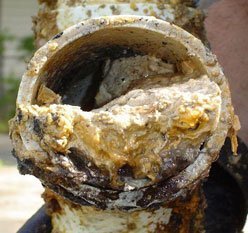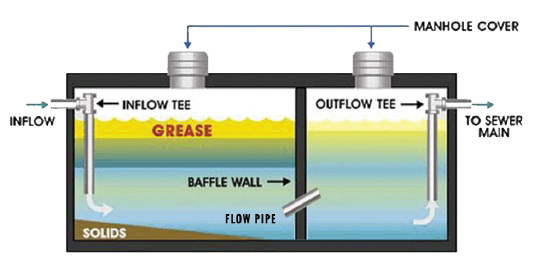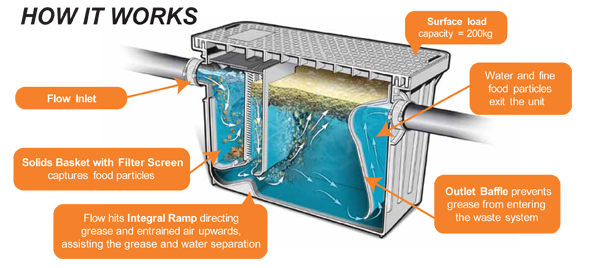What is FOG?
FOG refers specifically to fats, oils and grease entering the sewer system when poured down drains in homes, apartments, restaurants, industry and public facilities.

As a byproduct of cooking, FOG is usually found in:
- Baking goods
- Butter, lard, shortening
- Cooking oil
- Fats and oil from cooked meats
- Food scraps
- Gravy
- Mayonnaise
- Salad dressings
- Sauces
- Sour cream
Why is FOG a problem?
Blockage can lead to sewer overflows on your property. All too often, fats, oils and grease are disposed of improperly during food preparation and kitchen clean-up. When poured down the drain (sink or floor), FOG can build up, blocking sanitary sewer lines. This accumulation not only reduces the capacity of the wastewater collection system, but it also alters its effectiveness.
In severe cases, blockage can lead to:
- Sewage backups into homes and businesses and
- Sewers that overflow onto roadways and property, eventually flow into local waterways, causing contamination.
How can you help?
The easiest way to solve the grease problem and help prevent overflows of raw sewage is to keep this material out of the sewer system. Through education and by adopting certain habits, it is easy to minimize FOG sources at home.
In the kitchen, fats, oils and grease (FOG) comes mostly from pre-rinsing dishes or washing pots and pans. When cooking FOG is allowed to go down the drain, it cools in the wastewater system and sticks to pipes, creating FOG buildup. The buildup causes clogs and backups in homes and businesses, wastewater overflows, and spills onto private property, streets, and local surface waters. FOG buildup also increases the cost of maintaining Sussex County wastewater treatment systems, hence effecting rates and can also create public health problems.
Tips to keep your drains fat-free:

- Pour cooled fats, oils and grease into a container and put the container in the trash. If you don’t have a container, place tin foil into a coffee cup or similar, add FOG, allow to cool and dispose.
- Before washing, use a paper napkin or paper towel to wipe FOG from dishes and dispose of it in the trash.
- Use sink strainers to catch food waste.
- Put food scraps in the trash, not through the garbage disposal.

The best way to handle grease and fats are to scrape them off or pour them into containers and dispose of them through the trash disposal. Never put fats or grease down the sink drains or into the toilet.
There is a national campaign named "Can the Grease" throughout the United States that encourages the use of proper disposal of FOG.
Restaurants and other commercial kitchens are required to have grease traps or interceptors installed. These establishments are subject to inspection periodically by County personnel. Please contact us for more information.
What is a grease trap or grease interceptor and how does it work?
Grease traps and interceptors are devices designed to keep Fats, Oils and Grease (FOG) from entering building and public sewer lines. They can be located inside or outside of your kitchen, depending on the application. In general, they are designed to retain FOG-laden discharge long enough for grease in the water to cool, solidify and separate from the remaining waste. Once the grease has separated, it can be disposed of properly.
GREASE INTERCEPTOR

GREASE TRAP

Do I need to have a grease trap or interceptor at my restaurant or food service establishment?
Any establishment that handles any type of food should install a grease trap or interceptor. Even small food service providers like coffee shops who serve products with dairy should install a grease trap or interceptor to keep FOG from going down the drain. An establishment will be required to install a grease trap or interceptor if a side sewer has a visually evident accumulation of fat, oil or grease. Refer to the latest Uniform Plumbing Code (available at your public library) for sizing criteria.
How much does a grease trap or interceptor cost and who do I call to get one installed?
They vary in cost, depending on size and application and can start as low as few hundred to thousands of dollars. Please contact a certified plumber in the area for prices.
Who determines if I need a grease trap or interceptor?
If your food service establishment handles food and washes dishes, you most likely need to install a grease trap or interceptor. The decision will be based on the type of use and agreed upon by the engineer and county personnel.
Who is responsible for installing a grease interceptor?
Every establishment that handles food of any sort - from a coffee shop serving milk and other dairy products to a restaurant preparing deep-fried foods - is most likely discharging FOG. All food service providers are responsible for installing a device to keep FOG from entering their side sewer and the public sewer line.
What if I don’t install a grease trap or interceptor?
If your establishment handles any food that contains fat, oil and grease, you might eventually encounter a maintenance problem such as a blockage in the building sewer line. A blockage can create a sewer backup situation and ultimately a potential health problem for the establishment. If the problem is in the building sewer line, then the establishment is directly responsible for paying for the cleanup costs and property damage. An establishment may also be required to close for business until an inspector certifies all health issues are resolved.
If the blockage is in the public sewer main and Sussex County can verify that the practices of a specific establishment has caused the blockage, then that establishment may have to pay for the public cleanup costs, property damage and public sewer maintenance costs to relieve the blockage. The establishment will also be required to install a grease trap or interceptor or upgrade an existing device to intercept food and FOG.
How often should I clean my grease trap/grease interceptor?
A grease trap or interceptor should be regularly maintained to meet the 25% Rule – no more than 25%, by volume, of the trap or interceptor should accumulate of food and FOG. If more than 25% of food and FOG accumulate in the trap or interceptor, it is more likely to not be working properly and discharging food and FOG into your building sewer and the public sewer system. Exceptions to the 25% Rule are for devices that are designed to retain more than 25% FOG and will be specifically stated in the manufacturers specification.
Each establishment should work out a specific cleaning schedule that is right for their business. Some establishments will need to clean their trap or interceptor more often than others. It is important to remember that implementing kitchen best management practices, such as scraping your plates, pots, and pans, will reduce the amount of food and FOG that discharge into a trap or interceptor, therefore decreasing the frequency of cleaning.
How do I clean and maintain my grease trap/grease interceptor?
Grease trap maintenance is usually performed by maintenance staff or other employees of the establishment. Grease interceptor (GI) maintenance, which is usually performed by permitted haulers or recyclers, consists of removing the entire volume (liquids and solids) from the GI and properly disposing of the material in accordance with all federal, state, and/or local laws. When performed properly and at the appropriate frequency, grease interceptor and trap maintenance can greatly reduce the discharge of FOG into the wastewater collection system. The required maintenance frequency for grease interceptors and traps depends greatly on the amount of FOG a facility generates as well as any best management practices (BMPs) that the establishment implements to reduce the FOG discharged into its sanitary sewer system. In many cases, an establishment that implements BMPs will realize financial benefit through a reduction in their required grease interceptor and trap maintenance frequency. Refer to Best Management Practices for examples of BMPs that FOG generating establishments should implement.
Additional information:
Frequently Asked Questions about FOG
Prohibitions Relating to Discharge of Fats

